
 |
Gangs of New York (2002) Directed by Martin Scorsese Cast: Leonardo DiCaprio, Daniel Day-Lewis, Cameron Diaz, Jim Broadbent, Henry Thomas, John C. Reilly, Brendan Gleeson, Liam Neeson, Gary Lewis, Gary McCormack, Cara Seymour, David Hemmings, Stephen Graham, Roger Ashton-Griffiths 2002 – 168 minutes Rated: Reviewed by Dustin Putman, December 22, 2002. 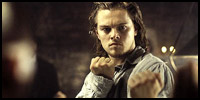 "Gangs of New York," filmmaker Martin Scorsese's historical epic about 19th-century urban criminality in New York City, has been a long time coming. Originally scheduled for release in 2001, it was pushed back following the events of 9/11, and then due to much-publicized feuds between Scorsese and Miramax over the length of the project. There is no doubt after watching the finished "Gangs of New York" that there were some overly generous edits made. Certain plot points and characters that were seemingly more developed in early cuts of the film are often skimmed over rather than thoroughly dealt with. For such a major motion picture from one of the most acclaimed directors working today, there are also a surprising number of continuity mistakes.
"Gangs of New York," filmmaker Martin Scorsese's historical epic about 19th-century urban criminality in New York City, has been a long time coming. Originally scheduled for release in 2001, it was pushed back following the events of 9/11, and then due to much-publicized feuds between Scorsese and Miramax over the length of the project. There is no doubt after watching the finished "Gangs of New York" that there were some overly generous edits made. Certain plot points and characters that were seemingly more developed in early cuts of the film are often skimmed over rather than thoroughly dealt with. For such a major motion picture from one of the most acclaimed directors working today, there are also a surprising number of continuity mistakes.
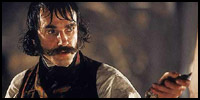 "Gangs of New York" is flawed and has several slow patches, and that is the bad news. The good news is that, on every other account, it is a remarkably ambitious and deeply powerful masterwork. A visceral experience that refuses to shy away from the pervasive violence that fills the frames, the movie builds to a climactic thirty minutes—depicting the New York Draft Riots of 1863—that are about as arresting as anything captured on celluloid this year.
"Gangs of New York" is flawed and has several slow patches, and that is the bad news. The good news is that, on every other account, it is a remarkably ambitious and deeply powerful masterwork. A visceral experience that refuses to shy away from the pervasive violence that fills the frames, the movie builds to a climactic thirty minutes—depicting the New York Draft Riots of 1863—that are about as arresting as anything captured on celluloid this year.
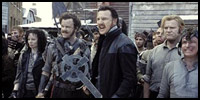 Set on Manhattan's lower end, "Gangs of New York" opens with a deadly fight between feuding gangs, led by the Irish Priest Vallon (Liam Neeson) and Native Protestant Bill "The Butcher" Cutting (Daniel Day-Lewis). Priest Vallon is, ultimately, murdered in cold blood by Bill, and witnessed by Vallon's young son, Amsterdam. Moving forward sixteen years, the now-grown Amsterdam (Leonardo DiCaprio) returns to his old neighborhood, the Five Points, with revenge on his mind. With the anniversary of Vallon's death approaching, Bill has marked it a celebratory holiday. Amsterdam is welcomed into Bill's twisted inner circle and, in the process, falls for beautiful pickpocket Jenny Everdeane (Cameron Diaz), who has ties of her own with Bill. As the drafting process for the Civil War gets underway with a biased prejudice against the poor, and Amsterdam's true identity about to be uncovered at any minute, the rising city of New York heads toward a shattering, life-altering showdown.
Set on Manhattan's lower end, "Gangs of New York" opens with a deadly fight between feuding gangs, led by the Irish Priest Vallon (Liam Neeson) and Native Protestant Bill "The Butcher" Cutting (Daniel Day-Lewis). Priest Vallon is, ultimately, murdered in cold blood by Bill, and witnessed by Vallon's young son, Amsterdam. Moving forward sixteen years, the now-grown Amsterdam (Leonardo DiCaprio) returns to his old neighborhood, the Five Points, with revenge on his mind. With the anniversary of Vallon's death approaching, Bill has marked it a celebratory holiday. Amsterdam is welcomed into Bill's twisted inner circle and, in the process, falls for beautiful pickpocket Jenny Everdeane (Cameron Diaz), who has ties of her own with Bill. As the drafting process for the Civil War gets underway with a biased prejudice against the poor, and Amsterdam's true identity about to be uncovered at any minute, the rising city of New York heads toward a shattering, life-altering showdown.
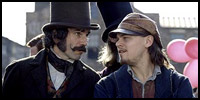 Color me uninformed, but I had no idea that New York City has had such a gritty, violent past, nor had I heard about the infamous Draft Riots of 1863. Besides being a lavishly mounted and thought-provoking production, "Gangs of New York" is also an intriguingly educational experience for non-history buffs. Written with passion and articulation by Jay Cocks, Stephen Zaillian, and Kenneth Lonergan, and directed with enormous skill by Martin Scorsese (1999's "Bringing Out the Dead"), the film's most astute achievement is in portraying the touchy class lines between the rich and poor, and the Natives and Immigrants.
Color me uninformed, but I had no idea that New York City has had such a gritty, violent past, nor had I heard about the infamous Draft Riots of 1863. Besides being a lavishly mounted and thought-provoking production, "Gangs of New York" is also an intriguingly educational experience for non-history buffs. Written with passion and articulation by Jay Cocks, Stephen Zaillian, and Kenneth Lonergan, and directed with enormous skill by Martin Scorsese (1999's "Bringing Out the Dead"), the film's most astute achievement is in portraying the touchy class lines between the rich and poor, and the Natives and Immigrants.
 Supported by cinematographer Michael Ballhaus (2000's "The Legend of Bagger Vance"), music composer Howard Shore (2002's "Panic Room"), and production designer Dante Ferretti (1998's "Meet Joe Black"), "Gangs of New York" gets the grand visual sweep and perceptive details just right in its portrait of a particular time and place in American history. Indelible images run throughout, but perhaps the most unforgettable are its opening and ending sections. Following the fatal fight between the two gangs at the onset, dead bodies litter the ground, their blood transforming the snow to crimson red. The finale of the Draft Riots is sheer brilliance in filmmaking, immensely involving, rewarding, and unshakably disturbing all at the same time. In other words, it is everything that the Battle at Helm's Deep was promised to be in "The Lord of the Rings: The Two Towers," but wasn't.
Supported by cinematographer Michael Ballhaus (2000's "The Legend of Bagger Vance"), music composer Howard Shore (2002's "Panic Room"), and production designer Dante Ferretti (1998's "Meet Joe Black"), "Gangs of New York" gets the grand visual sweep and perceptive details just right in its portrait of a particular time and place in American history. Indelible images run throughout, but perhaps the most unforgettable are its opening and ending sections. Following the fatal fight between the two gangs at the onset, dead bodies litter the ground, their blood transforming the snow to crimson red. The finale of the Draft Riots is sheer brilliance in filmmaking, immensely involving, rewarding, and unshakably disturbing all at the same time. In other words, it is everything that the Battle at Helm's Deep was promised to be in "The Lord of the Rings: The Two Towers," but wasn't.
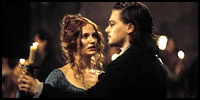 Leonardo DiCaprio (2000's "The Beach"), as Amsterdam, Daniel Day-Lewis (1997's "The Boxer"), as Bill the Butcher, and Cameron Diaz (2002's "The Sweetest Thing"), as Jenny, topline a sprawling cast. DiCaprio, in one of his first real "adult" roles, is thoroughly engrossing. Day-Lewis is frightening and appropriately unhinged, his steely glass eye refusing to allow anyone to peak into his broken soul. Diaz is excellent too, playing a complicated woman who has gone through a lot of heartache in her life but refuses to let it break her. The supporting players—particularly John C. Reilly (2002's "Chicago") and Jim Broadbent (2001's "Moulin Rouge")—seem to have suffered in the editing room. Although they are key to the story as it moves toward its conclusion, their development is sketchy, sometimes frustratingly so.
Leonardo DiCaprio (2000's "The Beach"), as Amsterdam, Daniel Day-Lewis (1997's "The Boxer"), as Bill the Butcher, and Cameron Diaz (2002's "The Sweetest Thing"), as Jenny, topline a sprawling cast. DiCaprio, in one of his first real "adult" roles, is thoroughly engrossing. Day-Lewis is frightening and appropriately unhinged, his steely glass eye refusing to allow anyone to peak into his broken soul. Diaz is excellent too, playing a complicated woman who has gone through a lot of heartache in her life but refuses to let it break her. The supporting players—particularly John C. Reilly (2002's "Chicago") and Jim Broadbent (2001's "Moulin Rouge")—seem to have suffered in the editing room. Although they are key to the story as it moves toward its conclusion, their development is sketchy, sometimes frustratingly so.
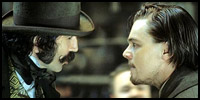 Jagged around the edges (the pacing could have been tightened and the story details expanded) but commandingly assured where it counts, "Gangs of New York" is, overall, not the brilliant motion picture so many have hoped for. At the same time, it is far more successful and satisfying than what its post-production problems might have suggested. Scorsese saves his most extraordinarily powerful image for last—a shot of a grave overlooking Manhattan as the past moves toward the present, ending on a shot with the World Trade Center prominently displayed. Alternately grim and beautiful, downbeat and hopeful, the film seems to be saying that time has the unfortunate power of changing and obscuring people's memories of the past. The obvious thing for Scorsese to have done was to end on the two towers disappearing, but instead he fades to black as they continue to stand tall and proud. We, as the audience, know how this skyline has since changed, and the lasting effect of such a notion is utterly devastating.
Jagged around the edges (the pacing could have been tightened and the story details expanded) but commandingly assured where it counts, "Gangs of New York" is, overall, not the brilliant motion picture so many have hoped for. At the same time, it is far more successful and satisfying than what its post-production problems might have suggested. Scorsese saves his most extraordinarily powerful image for last—a shot of a grave overlooking Manhattan as the past moves toward the present, ending on a shot with the World Trade Center prominently displayed. Alternately grim and beautiful, downbeat and hopeful, the film seems to be saying that time has the unfortunate power of changing and obscuring people's memories of the past. The obvious thing for Scorsese to have done was to end on the two towers disappearing, but instead he fades to black as they continue to stand tall and proud. We, as the audience, know how this skyline has since changed, and the lasting effect of such a notion is utterly devastating.
©2002 by Dustin Putman |
 |













